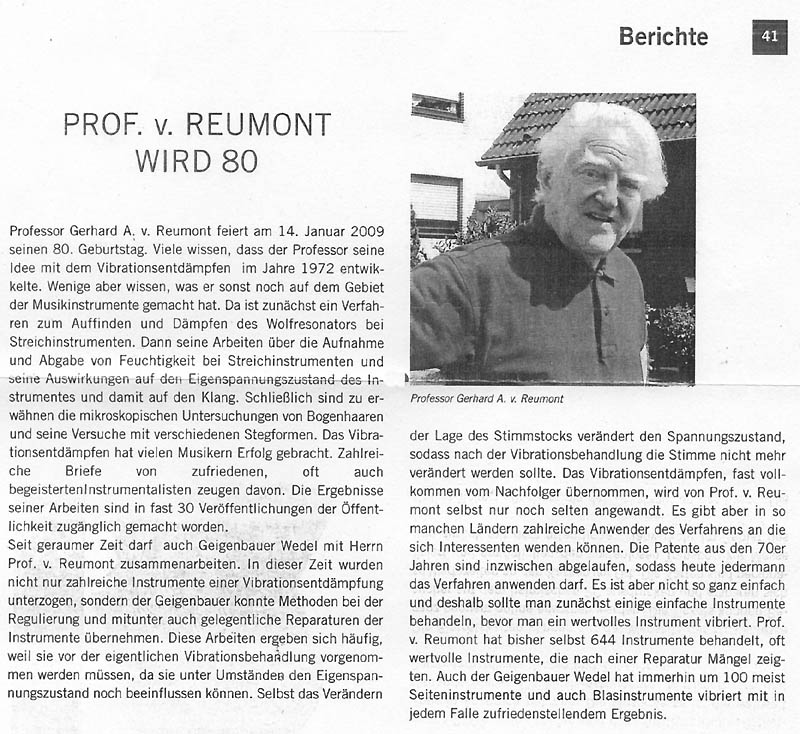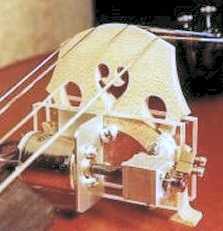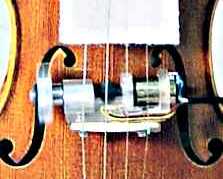The author turned 80 in early 2009. Here is an
article from the German magazine
Instrumentenbau-Zeitschrift for December
2008.
 VIBRATION
DEDAMPING NOTES - updated 2004
VIBRATION
DEDAMPING NOTES - updated 2004
This addendum is from www.HenryStrobel.com, via
the Book Catalog there.
(This photo of a von Reumont type cello vibrator
accompanied the book review by Joseph Curtin in the August 2000
Strad. Also shown is a newer Lehmann violin vibrator.
Photos by Henry Strobel.)


This book remains the practical guide to
"Vibration dedamping," which has been (like many
areas of violin making) more art than science. The quantitative
reduction in damping reported may contain errors of measurement and
interpretation, but this does not exclude the possible benefits of
the process, or of the book as a contribution to the art of violin
making.
There is further scientific information in a
paper by physicist Dr. Gottfried Lehmann. Part I was published in
the German periodical Instrumentenbau-Zeitschrift of
9-10/2000. Part II appeared in the 11/12-2000 issue, including
graphical data of measured response improvements after vibration.
Part III appeared in the July/August issue 7/8-2001, and compared
modal analyses before and after vibration treatment by the
Lehmanns, father Dr. Gottfried, and son professional cellist
Matthias, who built on the work of their friend and advisor, Prof.
von Reumont, and were later assisted in their modal analysis
measurements by Martin Schleske. Their conclusion also is that it
can result in greater volume, easier response, richness of
overtones, better bowing and more modulability. The specific
physical changes in the instrument are still unclear, but are
probably in areas such as glue joints, coatings, construction,
repair and humidity induced stresses, and in particular the
accelerated completion of creep, rather than in the character of
the wood as such. (Disclaimer: I am speaking not as a scientist
but as a publisher of books of interest to violin makers. I have
tried "vibration dedamping" a number of times, some with noticeable
improvements, some not. I have not used it commercially or
routinely.)
|
The Lehmann paper, Experiences and Observations
on the Effectiveness of a Procedure for Vibration Treatment of
String Instruments, is not generally available in English,
but Lothar Tews and I have translated it. All rights are reserved,
copyright 2001, by Gottfried and Matthias Lehmann, and it may not
be distributed or sold, but if you want to read a copy,
 Click here for the 8.2Mb download. Click here for the 8.2Mb download.
|
[Another source of corroboration of at least part of von Reumont's
findings is "The Playing In of Musical Instruments"
by Oliver Bartlett, University of Cambridge Department of
Engineering Fourth Year undergraduate project, 69 pages, 2001/2002.
His laboratory tests using a von Reumont type vibrator and a laser
vibrometer led him to conclude, among other things, that "forced
vibration of some violins can produce a non-reversible reduction to
their damping," probably due to speeding up of creep of the cell
lignin.]
Perspective: Originally I was
skeptical about the effects of "playing-in" an instrument,
considering it mainly a hopeful belief of musicians buying and of
dealers selling old instruments - those that "only needed a little
playing-in." Like so many things in the world of the violin, of art
and science, the objective and subjective may sometimes be resolved
only with difficulty. There is general agreement among musicians
that playing-in is real, and the "played-in" state of a violin is
by definition its normal state for purposes of comparison or
evaluation. The vibration dedamping treatment level far exceeds
that of normal "playing-in," so we assume it does something.
Subjective evaluation typically indicates an improvement well
beyond mere suggestion, and vibration dedamping seems more
effective than ordinary (low level) "playing-in". What about
objective verification? There is the German Patent Office'
investigation (J. Meyer, 1978), and the Lehmann paper. But the
objective measurement of violin quality is not easy, and changes
may be subtle, complex and variable from instrument to instrument
and time to time. Care is also needed to exclude other effects, as
of a soundpost inadvertently disturbed by the
vibration.
Vibration dedamping as described can apparently improve
some string instruments following original construction, storage or
but light use, or major repair. It can make no further improvement
in an instrument which is completely played-in, nor will it
compensate for design errors, such as a too thick graduation. It is
for use on complete, varnished instruments, not components. (The
obvious cautions for possible equipment failure damaging the
instrument apply.)
Note 1, Other Instruments: -
While the emphasis has been on the bowed instruments, work has also
been done with guitars, for example. See
Instrumentenbau-Zeitschrift of 7-8/97,
Neue Erkenntnisse beim Vibrationsentdaempfen von Gitarren,
pages 31-38 and 44-47. Improvements in volume, sustain, rapid
response, and tonal beauty are reported, and data are presented
showing increases in output level and sustain.
Note 2, Hardware: This can be
fabricated from the detailed information in the book, but the
author and inventor may be able to supply some. Write to Prof.
Gerhard A. v. Reumont, K?lberweg 8, 58453 Witten 6,
Germany
A stroboscope may be useful to measure motor speed or to
observe vibration amplitudes and wolf notes on the instrument. An
inexpensive example (only up to 10,000 rpm or 167 Hz) is DT-2239A
Digital Stroboscope, 115 VAC. See www.alfaelectronics.com?? (Henry
Strobel has no financial interest in such
sales.)
![]() Click here for the 8.2Mb download.
Click here for the 8.2Mb download.
 VIBRATION
DEDAMPING NOTES - updated 2004
VIBRATION
DEDAMPING NOTES - updated 2004
